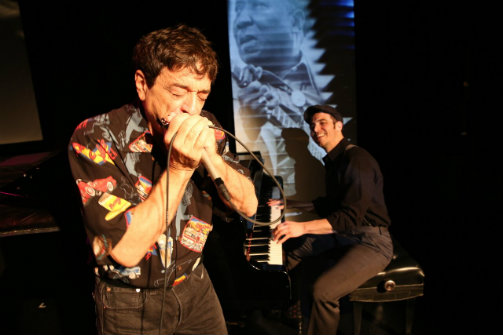
Boogie Stomp
By John Campana; Directed by Kirk Gostkowski
Off Broadway, Musical Performance
Open-ended Run
The Elektra Theatre, 300 West 43rd Street
by Shani R. Friedman on 10.12.15
 Bob Baldori and Arthur Migliazza in Boogie Stomp. Photo by Rebecca Scheckman
Bob Baldori and Arthur Migliazza in Boogie Stomp. Photo by Rebecca Scheckman
.
BOTTOM LINE: Two colossal piano talents bring America’s forgotten music—Boogie Woogie and Blues—roaring back to life.
Settling into my seat, I wonder how a couple of guys and their pianos are going to create a two hour show, especially for crowds whose music appreciation comes from scrolling through their iPhones. But audiences are in the tremendously skilled hands of Bob Baldori and Arthur Migliazza. Detroit-bred Baldori, who took up the piano when he was three, has played with many musical legends including Chuck Berry, Muddy Waters, John Hammond and Bo Diddley. Baldori wrote and directed the 2012 documentary Boogie Stomp, which inspired this production. Joining him on stage in his dapper fashions is Migliazza, a professional pianist since the age of 13 and a two-time International Blues Challenge finalist. Of their New York run Baldori cracks, “We finally made it here to the peep shows of 8th Avenue.”
Baldori and Migliazza possess a vast amount of knowledge when it comes to the origins of boogie woogie and blues, which of course features many African-American musicians who were either never known or have become forgotten by all but hardcore blues and jazz fanatics. The duo share background throughout on the songwriters they include, but not so that it becomes overwhelming or turns the evening into a lecture.
Starting from the earliest days of the sound, they let loose on “Boogie Woogie on the St. Louis Blues” by Earl “Fatha” Hines, a jazz pianist and Chicago band leader. Greats such as Dizzy Gillespie and Charlie Parker were members of the Hines big-band. As a very young kid in Chicago, Baldori saw Sonny Boy Williamson, who is considered the Godfather of the blues harp (harmonica) and wrote “Shake the Boogie” before he was murdered and another musician, Rice Miller, claimed his name and sound. Maldori is on the harmonica here while Migliazza works the piano, the two speaking/singing. Another songwriter who is showcased—Hersal Thomas—wrote “Suitcase Blues” before dying at age 20.
There are also easily recognizable songs in the repertoire like Waters’s “Got My Mojo Working,” which they encourage the audience to sing along to. We enthusiastically join in, some even barking when Maldori directs us. Chuck Berry gets a couple of shout-outs with “I’m So Glad I’m Living in the USA” and “School Days,” which Baldori fascinatingly demonstrates is a “note for note” rock version of “Honkey Tonk Train Blues,” written by Meade Lux Lewis in the 1920s, minus the guitar and lyrics.
My favorite moment of the night was one they say is improvised from the times when they’ve turned up to gigs and there’s only one piano. As Baldori explains, “Normally we call it four hands but since we’re in New York we thought we would call it foreplay.” They sit next to each other on the single bench although at various points Migliazza moves about, hilariously sitting behind Baldori while never pausing his playing. He also shows off his dance skills when Baldori plays solo and afterward jokes, “I almost started twerking. But you need the VIP tickets to see that.”
Campana, Gostkowski and choreographer Trina Mills have put together a rollicking show, working without a story and really only the musicians, their instruments and clips from the documentary to fill out the performance. With the joy and enthusiasm that Baldori and Migliazza exude, it transcends being simply a concert and becomes a meaningful and completely engaging exploration of the connection between history, art, pop culture and craftsmanship.
(Boogie Stomp plays at The Elektra Theatre, 300 West 43rd Street. Performances are Wednesdays through Fridays at 8, and Saturdays at 8:30. Tickets are $39-$99 and available at ovationtix.com or by calling 866-811-4111.)

